What to feed birds from the kitchen: 10 foods birds are sure to love and 5 to stay away from.
When it comes to what to feed birds from the kitchen we’ve got 10 foods you can serve and 5 others that aren’t safe for birds.

If you want to know what to feed birds from the kitchen you aren’t alone. Birds aren’t super common pets like cats and dogs, so it can be confusing trying to figure out what they can and can’t eat.
While you can definitely, serve up some of the best bird food, it may be easier to offer food that you already have. Luckily, the foods on this list are common items that can be found in most kitchens. Some of these are even items you might not have thought of but it turns out our feathered friends like a lot of the same foods we do.
It’s worth noting that younger birds have a different diet than older birds. So if you have a baby bird on your hands you may want to check out our guide on what to feed a baby bird. We also got advice from Dr. Rebecca MacMillan, on what is and isn’t safe to offer to the different types of birds you might see in your backyard, let's take a look.
What to feed birds from the kitchen

Now, before we get into our list Dr. MacMillan has pearls of advice for us. “Some of the healthiest options for birds include seeds, such as that left over from pumpkins or watermelons, and fruit. Popular fruits for wild birds include berries, bruised apples, bruised pears, and bananas.”
She also notes that you should cut food into small pieces to make it easier for birds to eat. Here are what we recommend offering your feathered friends.
Wagner's 53002 Farmer's Delight Wild Bird Food
This mix uses high-quality grains that will attract a variety of birds to your backyard. A blend of millo, millet, cracked corn, and sunflower seeds that birds will be sure to love.
Apples
When serving up this tasty treat, you’ll want to slice the apples up and remove the seeds. If you want to attract hummingbirds, slice the apple in half, scoop out part of the fruit, and fill it with sugar water before skewering it onto a feeder.
Get the best advice, tips and top tech for your beloved Pets
Bananas
Another crowd-pleasing fruit is the nutrient-rich banana and it’s so easy to dish up, simply remove the peel, chop it into rounds, and then place it on a tree stump or skewer.
Pumpkin seeds
Pumpkin seeds also make a great addition to a birdseed wreath. Check out these great birdseed wreath recipes for ideas on how you can make your own DIY version at home.
Raisins
Just make sure you soak them in some warm water first so they’re nice and soft and easy to eat.

Sweetcorn, peas, and potatoes
Although it’s a fiddly job, make sure you remove the outer skin from the peas and sweet corn as well as the potatoes. Dr. MacMillan these items are very appealing to birds.
Eggs and eggshells
Cooked eggs are packed full of nutrition and their shells are calcium-rich, which female birds need a lot of, especially when they’re nesting. Oh, and they’re good for digestion too, helping our beaked buddies to stay regular!
Cereal
As well as plain or toasted oats, you can also serve up bran flakes, corn flakes, or plain cereals with fruit and nuts, like low-sugar muesli. Before you give any cereal to birds, crush it with a rolling pin so there are no large chunks that could get stuck in their throat.
What not to feed birds

- Avocados
- Fruit pits and seeds
- Uncooked beans
- Salt
Dr. MacMillan also advises against serving cooked oatmeal as it can get stuck around the birds’ beaks. She also states, “Things like breadcrumbs, plain cooked pasta, pieces of pastry, or cooked rice should only be offered occasionally. Birds can fill up too much on these items which are lacking in essential nutrients, leading to an unbalanced diet.”
If you're interested in finding out what not to wild birds check out our vet's guide.
Loved this feature? Check out 32 tips for taking care of wild birds and 32 nutritious things birds can eat besides bird food. Or learn if you should help a baby bird

Kathryn is a freelance writer who has been a member of the PetsRadar family since it launched in 2020. Highly experienced in her field, she's driven by a desire to provide pet parents with accurate, timely, and informative content that enables them to provide their fur friends with everything they need to thrive.
Kathryn works closely with vets and trainers to ensure all articles offer the most up-to-date information across a range of pet-related fields, from insights into health and behavior issues to tips on products and training.
When she’s not busy crafting the perfect sentence for her features, buying guides and news pieces, she can be found hanging out with her family (which includes one super sassy cat and a kitten), drinking copious amounts of Jasmine tea and reading all the books.
She has written for a range of publications, including Fit&Well, Top Ten Reviews, LiveScience, Goodto, and Product Hunt.

